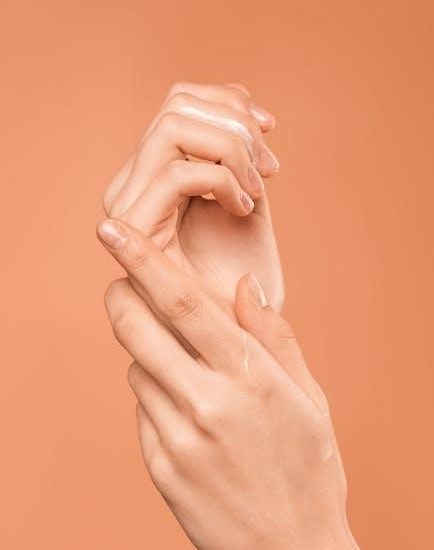Massage gun attachments come in various shapes, each designed for specific muscle areas. They enhance the effectiveness of percussion therapy, aiding in muscle recovery and pain relief.
1.1 Importance of Using the Right Attachments
Using the correct massage gun attachments is crucial for targeting specific muscle groups effectively. Each attachment is designed for unique purposes, ensuring optimal relief from soreness and tension. The right attachment prevents discomfort or injury, especially in sensitive areas. For instance, the round head is ideal for full-body relaxation, while the bullet head targets trigger points. Selecting the appropriate attachment enhances the massage experience, providing deeper relief and faster recovery. Proper usage also minimizes the risk of discomfort, making it essential to choose attachments based on your specific needs and muscle areas. This ensures safety and maximizes the benefits of percussion therapy.
1.2 Overview of Common Massage Gun Attachments
Massage guns typically come with a variety of attachments, each designed for specific purposes. The round attachment is gentle and versatile, suitable for full-body use. The bullet attachment targets trigger points with precision, offering intense relief. The fork attachment is ideal for spinal and sacrum areas, while the flat attachment is best for large muscle groups. Additionally, the air cushion attachment provides a softer touch for sensitive areas. These attachments cater to different needs, ensuring effective muscle recovery and pain relief. Understanding their unique functions helps users maximize the benefits of their massage gun experience.
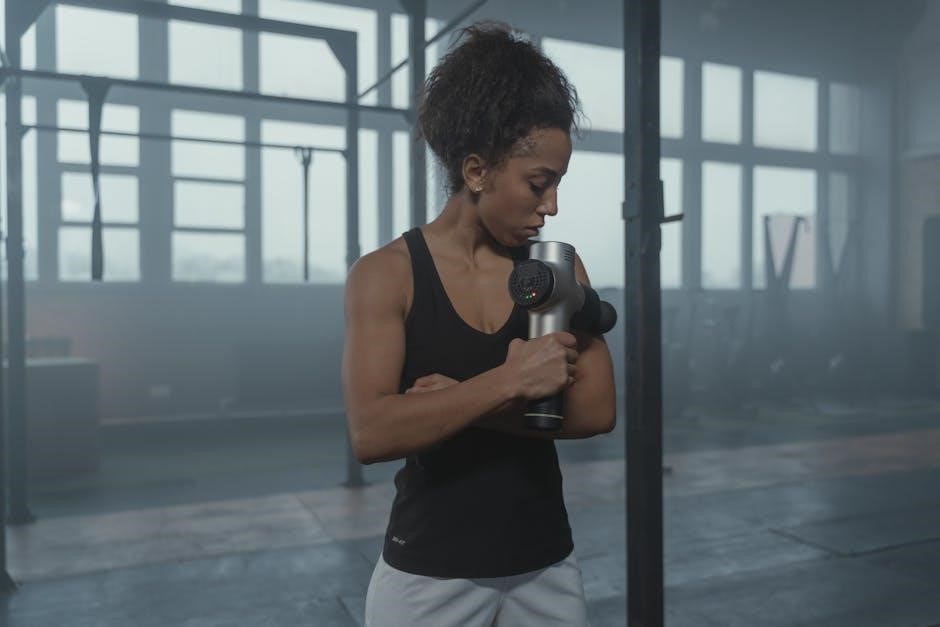
Types of Massage Gun Attachments
Massage guns feature various attachments, including round, bullet, fork, flat, and air cushion designs, each tailored for specific muscle areas and therapeutic needs.
2.1 Round Attachment
The round attachment is a versatile and gentle option, ideal for full-body relaxation. Its circular design allows for customizable pressure, making it suitable for sensitive areas like the neck, scapula, and sacrum. Many users prefer it for daily use due to its ability to reduce tension without causing discomfort. The round head is effective for loosening tight muscles and can be tilted to adjust pressure. It’s perfect for targeting large muscle groups and is often recommended as a must-have attachment for its all-around utility and gentle yet effective massage experience.
2.2 Bullet Attachment
The bullet attachment is designed for targeting specific trigger points and knots, offering intense pressure. Its smaller surface area makes it ideal for pinpointing areas like the piriformis, lats, and knots under the scapula. While effective, it’s not recommended for bony areas such as the neck due to its intensity. Users often use it on large muscle groups like the glutes and hamstrings to release tension. The bullet attachment is a powerful tool for deep tissue massage but should be used cautiously to avoid discomfort.
2.3 Fork Attachment
The fork attachment features a two-pronged design, making it ideal for targeting areas around the spine, such as the cervical and thoracic regions. Its unique shape allows simultaneous massage of both sides of the spinal erectors, providing relief from pain and discomfort. It’s also effective for the sacrum, away from the spine, where lactic acid buildup often occurs. While some find it intense for spinal use, it’s a great tool for large muscle groups, reducing massage time. Use it cautiously near sensitive areas to avoid discomfort.
2.4 Flat Attachment
The flat attachment is a versatile tool designed for medium and large muscle groups. Its smooth, dome-shaped surface provides maximum skin contact, offering a less intense massage. Ideal for areas like the calves, biceps, and entire back, it’s perfect for low-impact relaxation. Use it on sensitive regions such as the neck, shoulders, and sacrum, where a gentle touch is needed. It’s also effective for the IT band, hamstrings, and quads, making it a go-to for runners and individuals with lower body stiffness. Its subtle pressure ensures comfort while still delivering therapeutic benefits.
2.5 Air Cushion Attachment
The air cushion attachment is designed for sensitive areas, providing a gentle massage experience. Its cushioned surface absorbs shocks, making it ideal for bony or delicate regions. Perfect for users with sensitive skin, it reduces pressure points while offering relief. Use it on areas like the neck, arms, or legs for a soft, comforting massage. This attachment is great for those who prefer a less intense session without compromising effectiveness, ensuring a soothing experience for all body types.
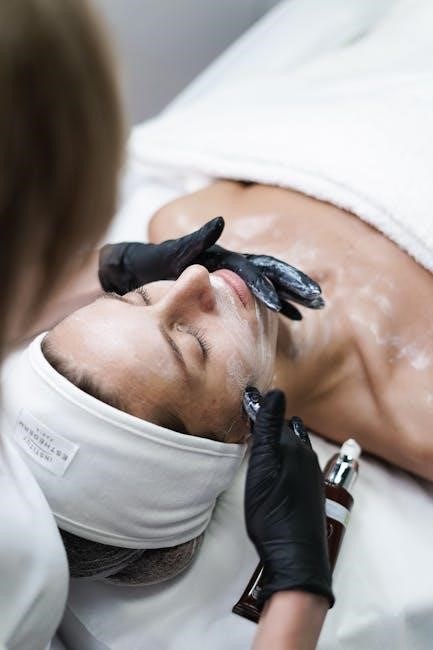
How to Use Each Attachment Effectively
Each attachment is designed for specific muscle groups, ensuring targeted relief. Adjust speed and pressure according to sensitivity, and combine attachments for optimal recovery and relaxation outcomes.
3.1 Using the Round Attachment for Full-Body Relaxation
The round attachment is ideal for full-body relaxation, offering gentle, customizable pressure. Its circular surface makes it suitable for sensitive areas like the neck and scapula. Use it on the sacrum for lower back relief and glutes for muscle tension. The attachment’s versatility allows for tilting to adjust pressure, making it perfect for daily use to reduce overall muscle tension and prevent injury. It’s a must-have for anyone seeking a soothing, comprehensive massage experience without intense pressure.
3.2 Applying the Bullet Attachment for Trigger Points
The bullet attachment is designed for targeting trigger points, offering intense, focused pressure. Its smaller surface area and pointed tip make it ideal for pinpointing knots, such as those under the scapula or in the piriformis muscle. Use it cautiously, as it can be intense even at lower settings. Avoid bony areas like the neck. The bullet is effective for large muscle groups, including the glutes and latissimus dorsi, helping to break up lactic acid and prepare muscles for deeper relief. It’s a powerful tool for addressing specific tension points and enhancing recovery.
3.3 Utilizing the Fork Attachment for Spinal and Sacrum Areas
The fork attachment is designed to target the spinal and sacrum areas, with its two-pronged design fitting perfectly around the vertebrae. It allows for simultaneous massage on both sides of the spine, making it effective for relieving tension along the cervical and thoracic regions. Use it gently near the sacrum to address lactic acid buildup and muscle tightness. While it can be intense, it’s also useful for large muscle groups, such as the glutes and hamstrings, offering a balanced approach to muscle recovery and relaxation.
3.4 Employing the Flat Attachment for Large Muscle Groups
The flat attachment is ideal for massaging large muscle groups, such as calves, quads, and hamstrings. Its dome-shaped design provides maximum skin contact, ensuring a gentle yet effective massage. Use it for sensitive areas like the neck, shoulders, and lower back, where a softer touch is needed. The flat attachment is also suitable for extremities, such as arms and legs, offering a delicate touch without applying excessive pressure. It’s perfect for full-body relaxation and works well for users who prefer a low-intensity massage while still addressing muscle tension and soreness.
3.5 Benefits of the Air Cushion Attachment for Sensitive Areas
The air cushion attachment is designed for sensitive areas, providing a gentle massage experience. Its cushioned surface absorbs shocks from the massage gun, reducing discomfort. Ideal for bony areas like the neck, shoulders, and spine, it offers a soothing experience without intense pressure. This attachment is also great for individuals with sensitive skin or those new to percussion therapy. By minimizing direct impact, it promotes relaxation and reduces muscle tension in delicate regions, making it a must-have for a comfortable and effective massage session. Use it to enhance your self-care routine with care and precision.
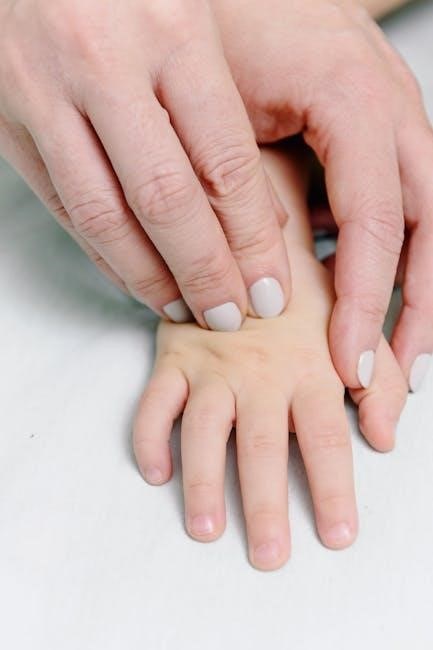
Best Practices for Massage Gun Usage
Always start with lower settings and gradually increase intensity. Use attachments suited for target areas to avoid discomfort. Keep the gun moving to prevent soreness and ensure optimal results.
4.1 Adjusting Speed and Intensity Settings
Properly adjusting speed and intensity is key to maximizing massage gun benefits. Start with low settings and gradually increase as needed. This approach ensures comfort and effectiveness, especially for sensitive areas. Higher speeds are ideal for large muscle groups, while lower speeds are better for targeting trigger points. Always consider personal tolerance and the specific attachment used, as certain heads may require lower intensity to avoid discomfort. Adjusting settings allows for a personalized experience, enhancing muscle recovery and relaxation. This customization is a major advantage of percussion therapy tools.
4.2 Maintaining Proper Technique to Avoid Injury
Using a massage gun requires proper technique to prevent injury. Always keep the gun moving, avoiding static pressure on one spot, especially over bones or sensitive areas. Start with low intensity and gradually increase as needed. Use attachments appropriately—flatter heads for larger areas and pointed tips for trigger points. Avoid applying excessive pressure, which can cause discomfort or injury. Be cautious near joints, spine, and bony areas. Maintain control and adjust settings based on personal comfort. Proper technique ensures safe and effective use, enhancing recovery without risking harm to muscles or tissues.
4.3 Combining Attachments for Optimal Results
Combining different attachments can maximize the benefits of your massage gun. Start with the round or flat attachment for full-body relaxation, then switch to the bullet for targeting specific trigger points. Use the fork attachment for spinal and sacrum areas, while the flat head works well for large muscle groups. Experiment with speed settings to tailor your massage experience. For sensitive areas, finish with the air cushion attachment to soothe the skin. By mixing techniques and attachments, you can address multiple muscle groups effectively, enhancing recovery and relief. Adjust as needed to ensure comfort and optimal results.
Maintenance and Care of Attachments
Regularly clean and sanitize attachments with a soft cloth and mild soap. Store them in a dry, cool place to prevent damage and ensure longevity.
5.1 Cleaning and Sanitizing Attachments
Proper cleaning and sanitizing of massage gun attachments are essential for hygiene and longevity. Use a soft, damp cloth with mild soap to wipe down each attachment, avoiding harsh chemicals. For tougher stains, a mixture of equal parts water and white vinegar can be effective. After cleaning, allow the attachments to air dry to prevent moisture buildup. Regular sanitization helps maintain cleanliness and prevents bacterial growth, ensuring safe and effective use for muscle recovery and pain relief.
5.2 Storing Attachments Properly
Proper storage of massage gun attachments is crucial for maintaining their effectiveness and longevity. Store them in a protective case or pouch to prevent damage and dust accumulation. Avoid exposing attachments to extreme temperatures, humidity, or direct sunlight, as this can degrade materials. Keep them in a dry, cool place, away from children and pets. For added protection, store each attachment separately to prevent scratches or damage. Regularly checking for wear and tear during storage can help ensure optimal performance. Proper storage habits extend the lifespan of your attachments and maintain hygiene for safe use.
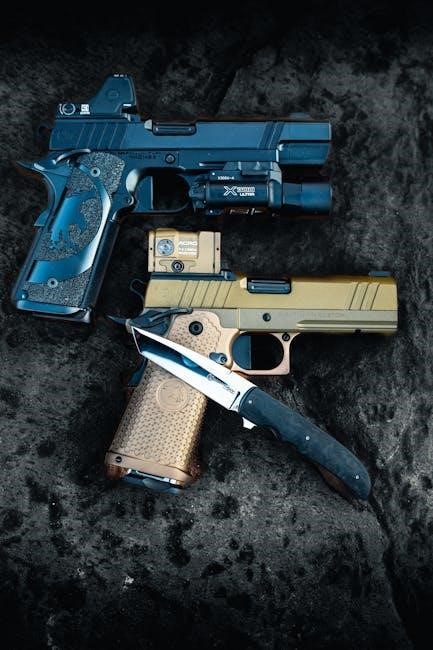
Troubleshooting Common Issues
Common issues include attachments not fitting properly or excessive noise. Addressing these involves checking alignment and lubricating parts, ensuring smooth operation and optimal performance.
6.1 Attachment Not Fitting Properly
If an attachment isn’t fitting properly, ensure it’s aligned correctly with the gun’s connection point. Gently twist and press until it clicks into place. If issues persist, check for debris or damage. Clean the attachment and gun head with a soft cloth. Lubricating the connection area can also improve fit. Avoid forcing it, as this might cause damage. Proper alignment ensures safety and effectiveness during use. Always refer to the user guide for specific instructions related to your massage gun model.
6.2 Reducing Noise or Vibration
To minimize noise and vibration, start by lowering the speed setting on your massage gun, as higher speeds often increase both. Using attachments with larger surfaces, like the round or flat heads, can also help reduce noise compared to smaller, more intense attachments like the bullet. Proper technique is key—hold the gun firmly but not overly tight, and avoid applying excessive pressure. Regularly cleaning the device and ensuring all parts are in good condition can also help. If noise persists, consider using a model with noise-reducing features or maintaining a consistent, gentle touch during use.
Massage gun attachments are essential for maximizing the benefits of percussion therapy. By selecting the right attachment for your needs, you can target specific muscle groups, reduce soreness, and enhance recovery. Proper technique, speed adjustment, and maintenance ensure optimal performance. Experimenting with different attachments and techniques allows for a personalized experience. Whether you’re an athlete or someone seeking relaxation, massage guns offer a versatile tool for muscle care. With the right approach, they can become an indispensable part of your wellness routine, providing relief and promoting overall well-being. Invest in quality attachments and use them wisely for lasting benefits.

